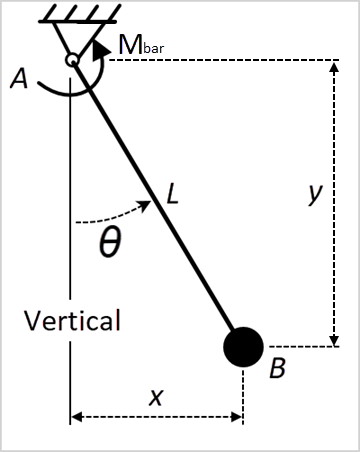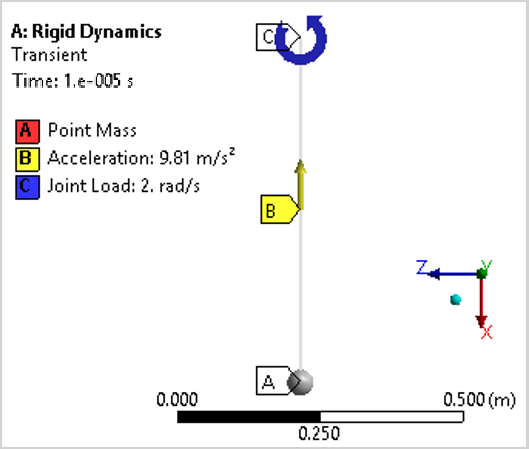VM-WB-MECH-105
VM-WB-MECH-105
Motion of a Pendulum Under Gravity Load
Overview
|
Reference: |
Da Silva, Marcelo R.M. Crespo. (2016). Fundamentals of Dynamics and Analysis of Motion. (1st ed., Vol 1). Mineola, NY: Dover Publications. 129-136. |
|
Solver(s): |
Ansys Mechanical |
|
Analysis Type(s): |
Rigid Body Dynamics |
|
Analysis Components |
Point Mass |
Test Case
Consider a pendulum consisting of a mass B attached to the free end of a pinned bar L. The system moves in a vertical plane, and the only forces acting on the mass are the gravitational attraction of the earth and the force applied to the bar. The bar is subjected to a known moment Mbar. Determine the minimum and maximum relative rotation of the bar.
| Material Properties | Geometric Properties | Loading |
|---|---|---|
|
Point Mass = 0.2 kg |
L = 60cm θ (0) = 0 |
Gravitation = 9.81 m/s2 Mbar = 0
|
Analysis Assumptions and Modeling Notes
Refer to Figure 143: Workbench Model below. The pendulum has a frictionless pinned end and a point mass on the free end. The bar is assumed to be massless so the bar's density is set to 1e-10 kg which is insignificant compared to the point mass of 0.2 kg. The stiffness behavior is set to rigid. Rotational movement is assumed to be in the vertical plane about the Y Axis, so a revolute joint restricts the movement to the XZ plane. The initial angular velocity of the bar is 2 rad/s. A gravity load of -9.81 m/s2 is applied to the model.
For Analysis Settings, the number of steps is set to two, and the end time step is set to two seconds. The first time-step is 1e-5 seconds. This step will establish the initial angular velocity condition.
An acceleration load of -9.81 m/s2 is defined in the X direction to model the gravity force. A Joint Load is applied to the Revolute - Ground to Massless Bar. The Type is set to Rotational Velocity. The initial step condition is set to 2 rad/s. The load is deactivated for the rest of the simulation.
For Solution Settings, a Joint Probe is scoped to the boundary condition Revolute - Ground to Massless Bar. The Relative Rotation Result is selected in the Z axis.
Results Comparison
The expected maximum relative rotation value (with a null applied moment) according to the formulation is 28.6 degrees. The minimum relative rotation is -28.6 degrees.
| Result | Target | Mechanical | Error (%) |
|---|---|---|---|
| Maximum Relative Rotation of the Massless Bar | 28.6 | 28.631 | 0.1080% |
| Minimum Relative Rotation of the Massless Bar | -28.6 | -28.633 | 0.1167% |




